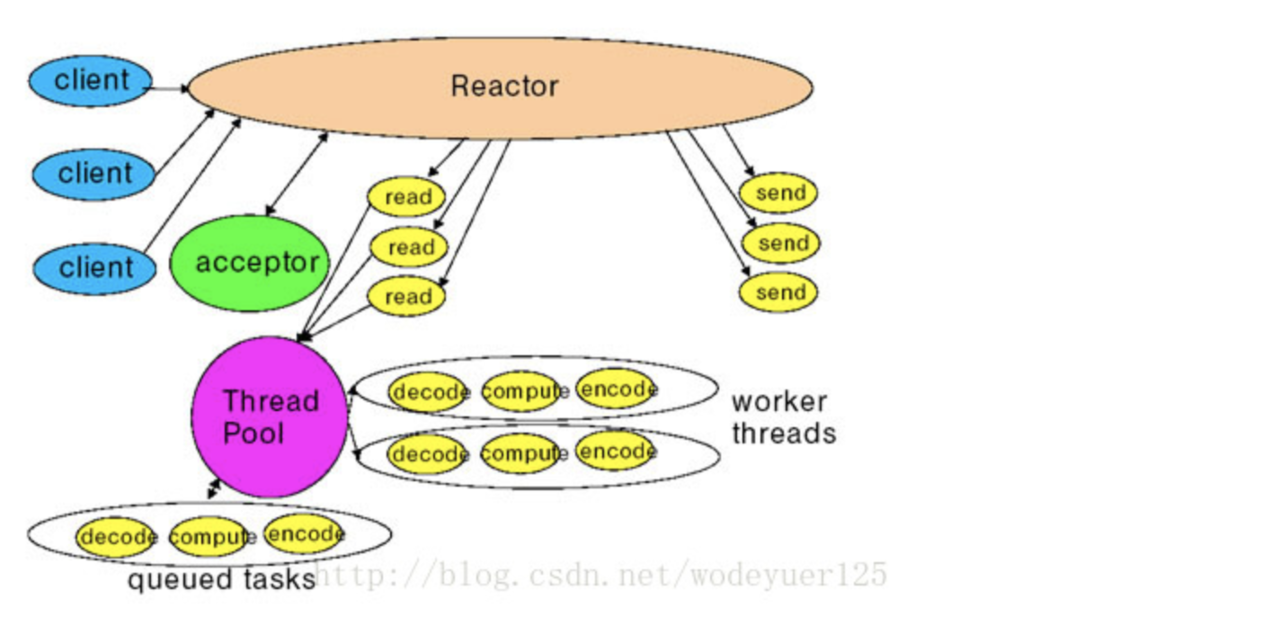BIO:线程发起IO请求,不管内核是否准备好IO操作,从发起请求起,线程一直阻塞,直到操作完成。如下图:

NIO(reactor模型):线程发起IO请求,立即返回;内核在做好IO操作的准备之后,通过调用注册的回调函数通知线程做IO操作,线程开始阻塞,直到操作完成。如下图:

AIO(proactor模型):线程发起IO请求,立即返回;内存做好IO操作的准备之后,做IO操作,直到操作完成或者失败,通过调用注册的回调函数通知线程做IO操作完成或者失败。如下图:

AIO代码
public class ServerCompletionHandler implements CompletionHandler<AsynchronousSocketChannel, Server> {
@Override
public void completed(AsynchronousSocketChannel result, Server attachment) {
//当有下一个客户端接入的时候 直接调用Server的accept方法,这样反复执行下去,保证多个客户端都可以阻塞
attachment.assc.accept(attachment, this);
read(result);
}
@Override
public void failed(Throwable exc, Server attachment) {
exc.printStackTrace();
}
private void read(final AsynchronousSocketChannel asc){
//读取数据
ByteBuffer buf =
ByteBuffer.allocate(1024);
asc.read(buf, buf, new CompletionHandler<Integer, ByteBuffer>() {
@Override
public void completed(Integer result, ByteBuffer attachment) {
//进行读取之后,重新标识位
attachment.flip();
//获取读取的字节数
System.out.println("Server -> " + "收到客户端的数据长度为:" + result);
//获取读取的数据
String resultData = new String(attachment.array()).trim();
System.out.println("Server -> " + "收到客户端的数据信息为:" + resultData);
String response = "服务器响应, 收到了客户端发来的数据: " + resultData;
write(asc, response);
}
@Override
public void failed(Throwable exc, ByteBuffer attachment) {
exc.printStackTrace();
}
});
}
private void write(AsynchronousSocketChannel asc,String response){
try {
ByteBuffer buf =
ByteBuffer.allocate(1024);
buf.put(response.getBytes());
buf.flip();
asc.write(buf).get();
} catch (InterruptedException e) {
e.printStackTrace();
} catch (ExecutionException e) {
e.printStackTrace();
}
}
public class Server {
//线程在池
private ExecutorService executorService;
//线程组
private AsynchronousChannelGroup threadGroup;
//服务器通道
public AsynchronousServerSocketChannel assc;
public Server(int port) {
try {
//创建一个缓冲池
executorService = Executors.newCachedThreadPool();
//创建线程组
threadGroup = AsynchronousChannelGroup.withCachedThreadPool(executorService,1);
//创建服务器通道
assc = AsynchronousServerSocketChannel.open(threadGroup);
//进行绑定
assc.bind(new InetSocketAddress(port));
System.out.println("server start , port : " + port);
//进行堵塞
assc.accept(this,new ServerCompletionHandler());
//一直堵塞 不让服务器停止
Thread.sleep(Integer.MAX_VALUE);
} catch (Exception e) {
e.printStackTrace();
}
}
public static void main(String[] args){
Server server = new Server(8765);
}
}
public class Client implements Runnable{
private AsynchronousSocketChannel asc;
public Client(){
try {
asc = AsynchronousSocketChannel.open();
} catch (IOException e) {
e.printStackTrace();
}
}
public void connect(){
asc.connect(new InetSocketAddress("127.0.0.1", 8765));
}
@Override
public void run() {
while (true){
}
}
public void write(String request){
try {
asc.write(ByteBuffer.wrap(request.getBytes())).get();
read();
} catch (InterruptedException e) {
e.printStackTrace();
} catch (ExecutionException e) {
e.printStackTrace();
}
}
public void read(){
ByteBuffer buf =
ByteBuffer.allocate(1024);
try {
asc.read(buf).get();
buf.flip();
byte[] respByte =
new byte[buf.remaining()];
buf.get(respByte);
try {
System.out.println(new String(respByte,"utf-8").trim());
} catch (UnsupportedEncodingException e) {
e.printStackTrace();
}
} catch (InterruptedException e) {
e.printStackTrace();
} catch (ExecutionException e) {
e.printStackTrace();
}
}
public static void main(String[] args) throws Exception {
Client c1 = new Client();
c1.connect();
Client c2 = new Client();
c2.connect();
Client c3 = new Client();
c3.connect();
new Thread(c1, "c1").start();
new Thread(c2, "c2").start();
new Thread(c3, "c3").start();
Thread.sleep(1000);
c1.write("c1 aaa");
c2.write("c2 bbbb");
c3.write("c3 ccccc");
}
}